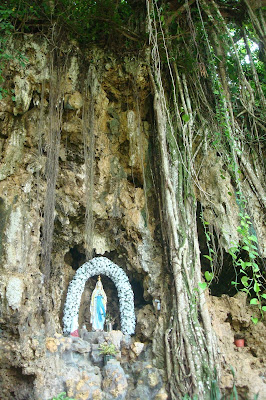On the eastern half of Saipan, around the middle of the island, is an area called As Teo. It is a heavily wooded area sloping from the higher ground of Mount Takpochao down towards the sea. Capitol Hill is to the north of it, and Kagman lies to the south of it.
WHY "AS TEO?"
It has been called As Teo for the longest time. So long ago, in fact, that no one remembers the reason why it is called As Teo. I have never come across anything in writing explaining the name. Maybe it exists somewhere, but I've never seen it. I doubt it exists. People didn't write these things down in the past.
The "As" in the name is Chamorro roughly meaning "at." In many cases, this is followed by a person's name, meaning "at so-and-so's place." On Guam, there are places named As Quiroga, after former governor Jose de Quiroga; As Gådao, named after the legendary chief Gådao; and As Don Lucas, after someone named Lucas of whom we know nothing. On Luta, there is a place called As Nieves, after an unknown woman by the name of Nieves.
But place names beginning with "As" do not always refer to human persons. As Aniti on Guam refers to spirits (aniti); As Måtmos on Luta refers to drowning.
So As Teo could perhaps refer to a person named Teo. If it does, chances are that Teo is a nickname for Mateo, Doroteo or Timoteo or some other male name that ends in Teo. Chamorro nicknames usually consist of the ending of the name, not the beginning. Jesus will become "Chu" in Chamorro, isolating the "sus" in Jesus and turning it into Chu. In English, however, Jesus will become Jess, starting with the beginning of the name.
Even if As Teo is named after a Mateo or some other man with a name that ends in Teo, we will never know anything about him.
If Teo does not refer to a person but rather to a thing, we have no way of knowing, at least as of today, what that thing is. There is no word teo in Chamorro, at least not in the Chamorro we speak today. The closest we get to that is teok (thick liquid), and whereas many people like to see direct connections between similar things, I prefer to refrain from such conclusions till we see evidence. To me, there is no reason why Chamorros would have said teo for teok. We don't see the dropping of final letters in Chamorro words in other instances. Shortening of Chamorro words was achieved by eliminating sounds inside a word, not at the end of them.(1)
MANY CAVES
Long before any human being lived in the Marianas, much of Saipan was underwater where limestone formations were coming together. What we see now at As Teo and in many other places all over the Marianas - limestone caves and cliffs - is what was formed underwater and was later exposed when the land rose above the sea.
These caves were used as shelters during the horrific bombardment of Saipan when the Americans came to take Saipan from the Japanese in June of 1944. Even the Japanese used a large cave in As Teo as a field hospital for their wounded.
THE BORJA FAMILY
Today, people immediately associate the As Teo area with a branch of the Borja clan known as i familian Tuhu. They own a lot of the land in As Teo. The land came into the Tuhu family by way of marriage into the Diaz family who were the original owners. Manuel Mendiola Borja (born on Guam) married Ignacia Sablan Diaz, daughter of Ramon Diaz and Rita Sablan, also originally from Guam.
SANTA LOURDES SHRINE
Some time after the war, as the Tuhu family continued to farm and eventually reside at As Teo, they took advantage of the natural environment and built a shrine to Our Lady of Lourdes in one of the crevices of the limestone cliff on their property.
The Virgin Mary had appeared in 1858 in a niche on the side of a large rock in the small French village called Lourdes.
 |
| Lourdes, France |
For many decades now, Catholics all over the world try to replicate this original grotto in a variety of styles. Where possible, grottoes are formed from crevices and niches found naturally in the environment, like As Teo.
Besides the good fortune of having crevices in the rock on their property to simulate the Lourdes grotto, the Tuhu family also had the blessing of a well at the same spot. At Lourdes in France, a spring of healing water burst forth at the Virgin's prompting. Indeed, As Teo made an almost perfect site for a Lourdes shrine.
Originally, there was just a well at As Teo. Recently, they have placed a pump there. The Church has made no statement about that water's spiritual significance, or lack thereof. But am sure the visitors find the water refreshing nonetheless. I have never tasted the water and don't intend to until I find out if it's safe to do so.
For many years now, the Santa Lourdes Shrine at As Teo is a crowded place due to the many visitors, Catholic and non-Catholic alike, from all over the Marianas and the world.
CHAMORRO HUMOR
A man in Saipan told me something that only a Chamorro would think of.
As I mentioned, the Borja family who live in As Teo and who run the Shrine are called the Tuhu family. Tuhu' in Chamorro means "to drip" or "to leak." The motion is downwards. But, as the man said, at Santa Lourdes Shrine, the water comes up from the ground below.
So, he said, the "dripping down" family (Tuhu) runs the shrine where the water springs up.
Ai. Only in Chamorro. Iyon i Tuhu i be'bo'! The spring belongs to the Tuhu!
THE MISSING SISTERS
Sadly, there is a tragic and final note to the story of As Teo.
It was at As Teo that two young sisters, Faloma and Maleina Luhk, went missing in 2011 and to this day have never been found. The sisters left their home in As Teo to catch the school bus, and were never seen again.
We pray that Faloma and Maleina are alive and well and will be found soon.
(1) An example of this kind of shortening a word in Chamorro is måktos. It comes from magutos. Gutos means "to break or snap," as in string or a cord. Instead of saying magutos, we shorten it in the middle of the word and say måktos.







Si yu'us ma'asi pale Eric pot i tinge-mu pot i sengsonghu yan i dos subrinahu. Gaigi gi ya'papapa, gi ge'haya asta i ladera, i sengsong "i pittot" lokkue. Ya dangkolu na si yu'us ma'asi na gagaige i dos malingo na patgon gi tinayuyot-mu. Puedi mohon u fata si yu'us i magahet na planu-ña para i dos ya u gaige giya guiya.
ReplyDelete